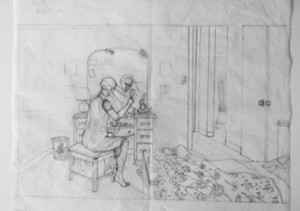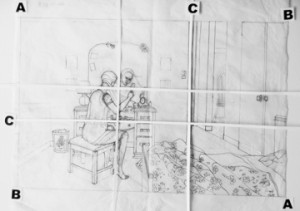JOAN’S PRINCIPLES OF ART (MADE SIMPLE!)
THE GOLDEN RATIO
Design elements need to be considered while developing a larger sketch for your art piece. You’ve played with thumbnail sketches. Now you can look for the points on your drawing that are established by the Golden Ratio. These points become a guide for placing a point of interest on the larger sketch.
The Golden Mean or Golden Ratio (sometimes called the Divine Proportion) was discovered by Greek mathematicians and used to study geometric figures and the properties of numbers during the sixth century BC. Euclid defined it in his thirteen volume work Elements in the third century BC. When used to determine the shape of a space, it is said to be the most appealing or satisfying proportion to the human mind.
To understand this ratio, draw a line. Label it AB. Place a point C on the line to divide the line into two portions. However to create the Divine Proportion, the division has to be done in such a way that AC (the longer portion) relates in size to CB (the shorter portion) in the same way (or ratio) as AB relates in size to AC.
Euclid determined that if CB equals 1, AC will be 1.6180339887… times the length of CB. (This is called the “extreme and mean ratio”.) Therefore AB = 2.6180339887….
So, if we find point C on the length and width measurements of our art piece, we can draw two horizontal lines and two vertical lines to determine four points of compelling interest on our sketch. These points become a guide rather than an absolute for placing something of interest in my compositional plan. Follow the steps below to find the four points on any size canvas.
Get your calculator ready. We will work with a 16″ x 20″ canvas.
Step 1: 20 divided by 2.618 = CB (The answer is 7.639″.)
Step 2: Multiply 7.639 by 1.618 = AC ( The answer is 12.359″.) 7.639″ + 12.359″ = 20″. Now you have the short portion and the long portion.
Step 3: Mark the 20” edge of your canvas or paper on the point 7.6” (eyeball the tenths, since a ruler is divided into eighths) from the bottom and again 7.6” from the top. Do the same on the other 20” edge. Draw a light line through the top points and the bottom points. I use chalk on my canvases. I lay strips of paper on my watercolor paper.
Step 4: 16 divided by 2.618 = CB (The answer is 6.111″.)
Step 5: Multiply 6.11 by 1.618 = AC (The answer is 9.885″.) 6.111″ + 9.885″ = 16″. Once again you have the long and short portions.
Step 7: Mark the 16” edges of your canvas or paper on the point 6.1” from the top and bottom edges on both sides.
Step 8: Where the four lines intersect, mark four points that will be useful in your composition as I did on the example above. I usually pick one point, but I am very aware of the other three as I plan the painting. I also consider the lines for the horizon or base lines of objects and for important verticals in the composition.
In the sketches below I placed the left edge of the door frame on vertical C. I also placed her elbow and ankle on the other vertical C. I drew the vanity jars on the horizontal C. Conveniently the head images face a point on the Golden Mean.

Photographers call this the “rule of thirds” as they plan the composition through their camera viewfinder. However, if you follow the Golden Ratio, the lines do not divide the paper into true thirds. Remember these points are only guides for me, not absolutes.
If you find this interesting, you will want to read The Golden Ratio by Mario Livio (ISBN 9780767908160). Half of the book is devoted to this ratio as it is found in nature, art and music. Fascinating!!!
The North Light Dictionary of Art Terms by Margy Lee Elspass (ISBN 0-89134-096-3, available used for a penny at Amazon.com) has an excellent drawing of how to determine the four points of the Golden Ratio through the geometric use of angles and arcs.
If you want the two side measurements of your canvas to relate according to the Golden Ratio, you can use the website goldenratiocalculator.com. This site allows you to type in one edge length of your canvas. It then shows you two other lengths that you can choose for the other edge of the canvas or paper. The two side measurements are close to the golden ratio of ac x ab or cb x ac. Try a drawing or two on paper using these proportions and see how it feels to your sense of proportion.
Watch for the next blog in which we will talk about color choices for your palette.






I am a special education math teacher who work at the same school as your daughter Virginia. I just wanted to let you know that I used your blog during real world application of proportions and ratios. I am impressed with your work and excellent explanation that you have posted. My stduents were very impressed with your work and they way you explained the concepts. My students realized that when you are an artist you need to understand math.
Again thank you so much for the work you do and for a great blog.